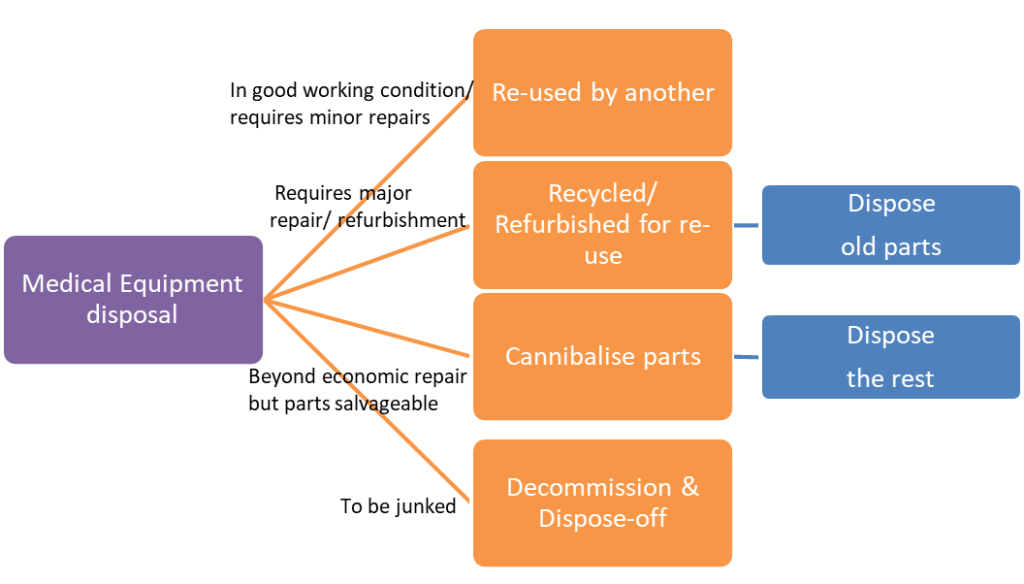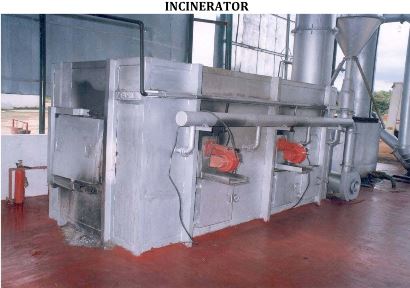
Healthcare providers regularly dispose-off used equipment. This may be due to the fact that they have been extensively used and are no longer in working condition or repairable. Often medical equipment is still in working condition but no longer needed, hence they are sold-off, donated or discarded. The discarded equipment could be used by another healthcare facility or cannibalised for parts. In essence medical equipment could be re-used by another party, re-cycled (Refurbished) for use by another party, cannibalised for spare parts or de-commissioned and disposed-off altogether. What happens to medical equipment disposed off altogether or what is medical waste management process?

Disposal of medical devices means burial, deposit, discharge, dumping, placing or release of waste material into or on air, land or water in such a manner as to be irretrievable.
Since the medical equipment waste ultimately goes to the land, water or air – such disposal must be done with a lot of caution. Waste produced from health care activities if not treated properly or not handled with precaution can pollute soil, water and air. This could potentially cause infection and injury to people unintentionally coming in contact with it.
As much as possible, medical equipment should be reused and waste minimized when found safe and practical.
Whatever the status may be, when a reusable medical device is being disposed-off, whether by way of donation, sale, buy-back trade-in, internal transfer, and refurbishment or condemnation for disposal altogether; proper decontamination procedures must be observed.
WHO guidelines are also concerned that any risks related to decommissioning should be assessed. Consideration should be given to the health and safety of patients, the public, environment, health care workers and all parties handling the equipment at all stages including refurbishment, cannibalisation, repair or ultimate disposal.
Medical equipment waste categorization and segregation at source
The first step in handling medical equipment and device waste is segregation at source.
Proper segregation and to an extent de-contamination of medical equipment being disposed is the responsibility of the healthcare provider. Health care waste is categorized as either hazardous or non-hazardous. Health care personnel must be trained in procedures for managing all types of medical device waste. Medical devices should be segregated at source by the health care worker who generated the waste in the right colour-coded bags.
| Waste category | Description and examples |
| Hazardous | Sharps Used or unused sharps (e.g. hypodermic, intravenous and other needles, auto-disable syringes, syringes with attached needles, infusion sets, scalpels, pipettes, knives, blades and broken glass) |
| Infectious | Waste suspected of containing pathogens that poses a risk of disease transmission (e.g. waste contaminated with blood and other body fluids, laboratory cultures and microbiological stocks and waste including excreta and other materials that have been in contact with patients with highly infectious diseases in isolation wards). Pathological Human tissues, organs or fluids (e.g. body parts, fetuses and unused blood products) |
| Pharmaceutical, cytotoxic | Pharmaceuticals that have expired or are no longer required and items contaminated with or containing pharmaceuticals; cytotoxic waste containing genotoxic substances e.g. waste containing cytostatic drugs and genotoxic chemicals) |
| Radioactive | Waste containing radioactive substances (e.g. unused liquids from radiotherapy or laboratory research, contaminated glassware, packages or absorbent paper, urine and excreta from patients treated or tested with unsealed radionuclides and sealed sources) |
| Electronic waste | Waste containing electronic components and parts (for e.g. batteries, printed circuit boards, embedded electronic parts, piezoelectric crystals etc.) |
| Non-hazardous | General health care Waste that does not pose a biological, chemical, radioactive or physical hazard |
Out-sourcing bio-medical waste management
Most healthcare facilities outsource the bio-medical waste disposal beyond this point to government authorised waste handlers. Safe, reliable management of health care waste is essential to protect health care workers, public health and the environment.
Medical devices must then be treated to reduce potential health and environmental hazards. Medical devices should undergo thermal, chemical, radiation, biological or mechanical treatment. For hazardous (infectious) waste, disinfection or sterilization is required to minimize potential disease transmission.
Government authorised bio-medical waste handlers are responsible for safe collection, transportation and temporary storage of waste material collected from healthcare providers. After this they perform some of the following processes to treat the medical waste:
The most common treatment options for infectious medical waste management are:
• steam treatment (autoclaving),
• integrated steam treatment (hybrid autoclaves or advanced steam treatment),
• microwave treatment,
• dry heat treatment,
• chemical treatment (internal shredding or chemical disinfectants) and
• incineration (combustion, pyrolysis or gasification).
In addition shredders, grinders and compactors are used.
Incineration

Waste in the Yellow Bags Category should be disposed through Plasma Pyrolysis unit or twin chambered compact incinerator with minimum 2 seconds retention time in secondary combustion chamber. The double chambered incinerator has temperature of 8500 C (1st Chamber) and 10500 C (2nd Chamber). The flue gas is passed through wet venturi scrubber with packed tower de-mister for air pollution control and the clean air is let out through 30m chimney. The chimney exhaust are monitored for NOx, SO2, CO and SPM levels as per local pollution control board standards every month.
The Incinerated ash is packed and sent to hazards land fill facility and scrubbed water is treated in Effluent Treatment Plant.
Autoclaving
Waste in the Red Bags Category – mostly recyclable plastic, are disinfected in high pressure (15 PSI) -high temperature (1210C) autoclave for a resident time of 45 minutes, with the level of disinfection monitored through spore test on a weekly basis.
Shredding/Grinding/Compacting
The treated waste is shredded in high pressure shredder and sent for recycling. This could be metal or plastic waste that is recyclable.
Water from the autoclave is also treated in ETP.
Waste sharps are also disinfected in autoclave with above mentioned process and sent for recycling, after separating and disinfecting needles in disinfection tanks with 1% Hypochlorite Solutions for a minimum of 8 hours. After dis-infection, needles are sent to hazardous landfill either as-is or after incineration as ash.
Effluent water Treatment
Both the waste water and treated water are tested regularly for required parameters – pH, suspended solids, Oil and grease, BOD and COD. Effluent water treatment is a critical part of medical waste management.
Land disposal
Controlled landfilling involves use of practices and improved engineering design to reduce impacts on health and the environment. A Sharp pit must be a 1m ×1m×1m concrete lined circular or rectangular pit and Pit can be dug and lined with brick, masonry or concrete rings. The pit should be covered with a heavy concrete slab, in which a galvanized steel pipe of about 1.0m height and suitable diameter is fixed to feed the shredded or mutilated sharps waste. – The top opening of the steel pipe shall have a provision of locking after the treated waste sharps has been disposed in. Once a pit fills upto 3/4th capacity, it can be encapsulated with binding material like cement. Once encapsulated mass is dry, sharp pit is sealed.
In addition to treatment of waste before disposal, better engineering standards are used to ensure geological isolation of waste from the environment and to ensure that they are covered daily. Engineered landfills are intended to: minimize contamination of soil, surface water and groundwater; limit atmospheric releases and odours; block access to waste by pests etc.; and prevent contact of the public.
Since the medical equipment waste ultimately goes to the municipal landfill, into water or released into air, as much as possible, items should be reused and waste minimized when found safe and practical.
Reduce, Repair, Re-use, Recycle – follow the 4R Mantra for medical waste management!
—————————————————————————————————————————
PrimedeQ is an e-Marketplace for buying, selling, renting, servicing and spares of medical equipment. We offer all types of used / refurbished medical equipment , including cathlab, ECG machine and other diagnostic equipment, endoscopes, OT equipment, Laparoscopic Equipment, Lab equipment, X-Ray, TMT, anesthesia machine, ultrasound machines etc. We offer repair services for all types of medical equipment including Lab equipment, microdebrider, laparoscope , rigid and flexible endoscopes as well as EUS (Endoscopic Ultrasound Units) and ultrasound probe etc.
Contact us for any medical equipment requirements 7019759765.






